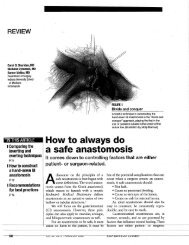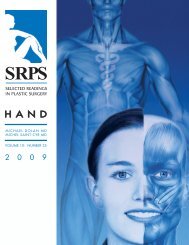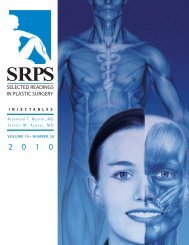Craniofacial Anomalies, Part 2 - Plastic Surgery Internal
Craniofacial Anomalies, Part 2 - Plastic Surgery Internal
Craniofacial Anomalies, Part 2 - Plastic Surgery Internal
You also want an ePaper? Increase the reach of your titles
YUMPU automatically turns print PDFs into web optimized ePapers that Google loves.
Fig 24. Interocular distance measured from inner canthus to<br />
inner canthus. A, normal. B, primary telecanthus. C, true ocular<br />
hypertelorism. D, ocular hypertelorism with secondary<br />
telecanthus. (Reprinted with permission from Cohen MM Jr,<br />
Richieri-Costa A, Guion-Almeida ML, Saavedra D: Hypertelorism:<br />
interorbital growth, measurements, and pathogenetic considerations.<br />
Int J Oral Maxillofac Surg 24:387, 1995.)<br />
osteotomy mobilizing the lateral, inferior, and medial<br />
orbital walls as a single bloc. The maximum correction<br />
that is possible with medial orbital wall mobilization<br />
is 10mm; with a U-shaped osteotomy, 15mm.<br />
The intracranial approach as described by<br />
Tessier 368,369 with Converse’s modification 433 is preferred<br />
in all severe cases of hypertelorism or when<br />
the cribriform plate lies below the level of the<br />
frontonasal suture (Fig 26). The entire orbit is mobilized<br />
as a box, providing total control of the intracranial<br />
contents.<br />
McCarthy and colleagues 434 report correction of<br />
orbital hypertelorism on 20 children age






